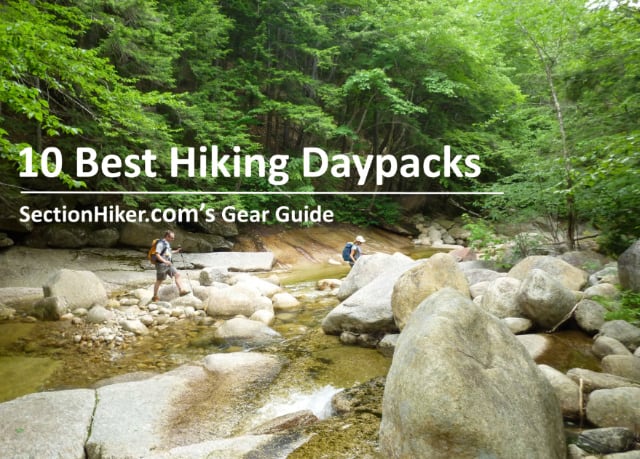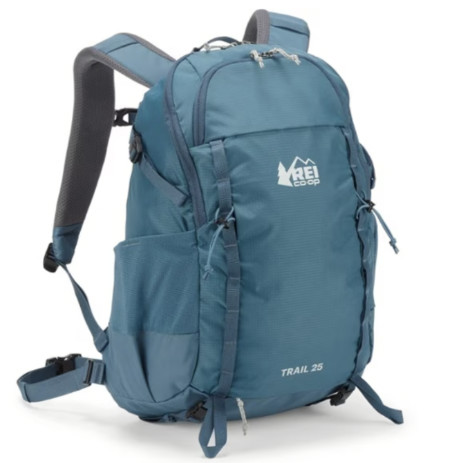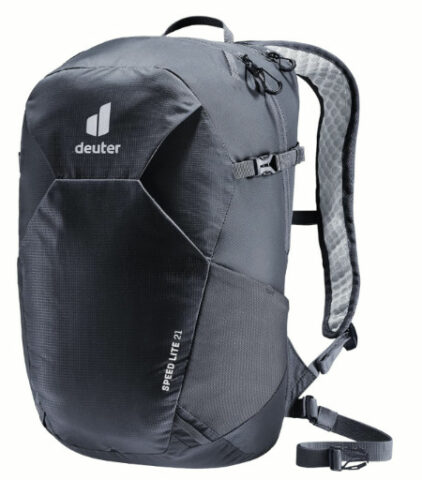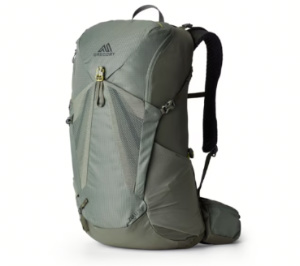
The best hiking daypacks are functional, fit well, and durable. They have to be because they’re your home away from home, carrying all of your essentials including outdoor gear, food, water, and survival gear. Many daypacks are also good for multiple sports including mountain biking, climbing, skiing, or snowboarding. You can also use them for commuting or travel.
| Men's Model | Sizing | Women's Model |
|---|---|---|
| Osprey Talon 22 | Adjustable Torso | Osprey Tempest 20 |
| REI Flash 18 | Fixed Length | REI Flash 18 |
| TNF Borealis 28 | Fixed Length | TNF Borealis 27 |
| Osprey Stratos 24 | Adjustable Torso | Osprey Sirrus 24 |
| Deuter Speed Lite 21 | Fixed Length | Deuter Speed Lite 21 |
| REI Trail 25 | Fixed Length | REI Trail 25 |
| Gregory Zulu 30 | Adjustable Torso | Gregory Jade 28 |
| Gregory Nano 22 H2O Pack | Fixed Length | Gregory Nano 22 H2O Pack |
| Deuter Trail 30 | Fixed Length | Deuter Trail 28 SL |
| Mystery Ranch Scree 33 | Adjustable Torso | Mystery Ranch Scree 33 |
But with the hundreds of daypacks out there, it can be hard to determine which are the best for hiking, overnight backpacking, or other sports. That’s why we created this list of day packs that we recommend to hikers, backpackers, and other outdoor enthusiasts. No matter your goals or passions, there’s a backpack on this list that will fit your needs and should be on your shortlist.
1. Osprey Talon 22 Daypack

| Shop at REI | Shop at Amazon |
2. REI Flash 18 Daypack
3. The North Face Borealis 28
| Shop at REI | Shop at Amazon |
4. Osprey Stratos 24 Backpack
| Shop at REI | Shop at Amazon |
5. REI Trail 25 Daypack
6. Deuter Speed Lite 21 Daypack
| Shop at REI | Shop at Amazon |
7. Gregory Zulu 30 Backpack
| Shop at REI | Shop at Amazon |
8. Gregory Nano 22 H2O Hydration Pack
9. Deuter Trail 30 Daypack

| Shop at REI | Shop at Amazon |
10. Mystery Ranch Scree 33 Daypack
| Shop at REI | Shop at Amazon |
Hiking Daypack Buying Guide
Consider these variables when buying a backpack for day packing:
Daypack Volume
How big should a daypack be? Most daypacks range in size from 20L up to 35L in volume. The size you need depends on the length of your hikes and how much clothing and gear you need to carry to protect yourself against wind, rain, or snow. While a lower capacity backpack is sufficient for 1/2-day hikes, we recommend sizing up in the 30L to 35L range for all-day hikes, peak bagging, or hut-to-hut trips where you need to carry extra food, clothing layers, water, and the 10 Essentials. See our article, How to Size a Backpack: Daypack and Backpack Volume Guide, for a more in-depth discussion.
Price
Daypacks are a lot less expensive than multi-day backpacks, but you can expect to pay anywhere between $50 to $200, at the high end. You can usually find a good daypack in the $100 dollar range, but expect to pay more for more volume or an adjustable length frame. Many backpack manufacturers update their backpacks once a year, so we recommend checking in the outlet section of your favorite retailer for last year’s model. Previous year daypacks are usually just as good and considerably less expensive. Check out the REI Outlet to find the best selection.
Activities
Most daypacks can be used for multisport activities including hiking, mountain biking, climbing, skiing, or snowboarding. For example, if you intend to use your pack for hiking and mountain biking, look for ones with a helmet holder, a blinky light attachment, and reflective accents. For hiking and climbing, look for daypacks that can carry extra climbing gear, including ropes, can be worn with a climbing harness, and have a place to hold your helmet. For hiking and skiing or snowboarding, look for daypacks that have an insulated hydration pocket, straps to hold skis or a board, and a place to stash a shovel, avalanche beacon, and probe.
Adjustable Length
Backpack sizing, like clothing size, is usually the most important variable in whether a daypack feels good to wear or not. Backpacks are sized by something called torso length, which measures the distance between your hips and the tops of your shoulders. An adjustable-length backpack lets you resize a daypack so it fits you exactly, like a custom-tailored suit. It’s a premium feature and very desirable. Fixed-length backpacks are sized to fit a range of torso lengths, something like 16″-19″, which can result in a bad fit if your torso length is at the end of the sizing range. We recommend that beginner day hikers buy an adjustable-length backpack so they can experiment with different torso lengths and dial in a proper fit.
Ventilation
If you hike in hot or humid weather or sweat a lot, consider getting a ventilated backpack that increases airflow behind your back. It can make a real difference in your comfort level by keeping your back cool and your shirt dry. Backpack ventilation varies widely though. Some packs have a mesh-covered cavity, that provides extra airflow. These work best. Still, others have air channels that run between the back padding or foam cutouts in the pack frame to encourage airflow.
Rain Cover
Many daypacks include a rain cover, which can save you the hassle and expense of buying one separately. While you can line your daypack with a plastic garbage bag, they don’t protect the smaller pockets at the top of your pack where you probably store your most valuable items.
Pockets and Organization
The biggest difference between backpacks lies in the way their pockets and storage are organized. Most backpacks have open pockets exposed to the elements and closed pockets to keep items clean and dry. Open pockets are good for frequently accessed items like a jacket, sweater, snacks, water bottles or a water filter. You don’t want to stop and dig around your backpack every time you need one of these items. Open pockets are also good for storing damp items, so they dry and don’t make the gear inside your backpack damp too. Closed pockets including the main compartment, are good for storing items you need less frequently and want to keep dry and safe, like your keys, cell phone, first aid kit, an insulated jacket, or a laptop. Most backpacks will have a combination of these.
Here are a few things we look for when choosing between daypacks:
- If you carry water bottles instead of a hydration system, make sure you can reach bottles stored in the side pockets without taking off your backpack.
- If you plan to store electronics or valuables in a hip-belt pocket, look for daypacks that have solid hip-belt pockets, not ones covered in mesh, because they’re more durable and water-resistant.
- Backpacks with top lids usually have excellent pockets for the smaller items that you want frequent access to.
- A front stretch mesh pocket is good for stuffing layers in for three-season hiking, but a front pocket made with solid material is better for winter hiking because it’s more durable and water-resistant.
Hydration Compatibility
All daypacks and backpacks are hydration system compatible, so that shouldn’t be a concern. Most require that you purchase a hydration system, however, which can get expensive. To save money, look for backpacks with mesh side pockets that can be used to carry water bottles instead.
Weight
The weight of a daypack is less important than the weight of a multi-day backpack because you can’t carry as much gear, food, or water. While it’s always good to carry less weight, don’t compromise your personal safety to do so. We recommend that you get a daypack that won’t collapse on itself when packed and rides on your hips and not on your shoulders. Look for packs that weigh 40 ounces or less. That’s a good weight limit that should still provide you with plenty of choices.
Hip Belts
Daypack hip belts vary in the amount of padding they provide. Some daypacks don’t come with hip belts, some come with a thin webbing strap, and others come with lots of padding and pockets. Simple unpadded hip belts are used to keep a daypack from bouncing against your hips and back when you walk, while hip belts with more padding are designed to take the weight off of your shoulders and shift it to your hips. Proper fit is very important when fitting a padded hip belt. See our article How Should a Backpack Hip Belt Fit? for an in-depth explanation.
Shoulder Straps
Shoulder strap thickness also varies by daypack volume with larger volume packs having more padding. Here are a few things we look for:
- The sternum strap should be easily adjustable. Sternum straps connected to a rail are the easiest to adjust.
- If you plan to attach accessory pockets to your shoulder straps, look for ones that have webbing loops that you can thread a clip through.
- High-volume daypacks should have load lifter straps. These can help shift more weight off your shoulders and onto your hips. They’re particularly good for carrying heavier loads, for winter hiking, climbing, or skiing & snowboarding.
Women’s Daypacks
We believe that women should have the option to use a female-specific backpack instead of one designed for a man (what passes for unisex.) Women’s backpacks are available in smaller sizes, they have shoulder straps that wrap around breasts instead of smashing them flat, and hip belts that wrap around curvy female hips instead of the square boxy ones needed by men.
More Questions?
If you have any questions, leave us a comment below and we’ll be sure to respond. Our mission is to help people and we make a point to respond to all reader questions.
Check Out All of SectionHiker's Gear Guides!
- 10 Best Hiking Shoes and Trail Runners
- 10 Best 2-Person Backpacking Tents
- 10 Best 1-Person Backpacking Tents
- 10 Best Backpacking Stoves
- 10 Best Backpacking Water Filters
- 10 Best Lightweight Backpacks
- 10 Best Ultralight Backpacks
- 10 Best Backpacking Sleeping Bags
- 10 Best Ultralight Backpacking Quilts
- 10 Best Lightweight Backpacking Chairs
- 10 Best Backpacking Sleeping Pads
- 10 Best Backpacking Rain Jackets
- 10 Best Hiking Daypacks
- 10 Best Hiking Pants
- 10 Best Trekking Poles
 SectionHiker.com Backpacking Gear Reviews and FAQs
SectionHiker.com Backpacking Gear Reviews and FAQs 







Good stuff!
I have a Deuter Speed Lite 21 “summit pack” which appears identical to the pack reviewed except coloration, the one I still use is black and gray with yellow interior. Mine has a plastic support inside which truly helped distribute a relatively light load. My pack was acquired circa 2008 but the design is the same. In any event, the Deuter performed so well for me with exception of lateral stability that I will buy another once the original, which is currently partly duct tape, serves no purpose and is retired. In terms of lateral stability, your loads are going to shift left or right if you stuff the pack as you move side to side, say, by navigating boulders, and it can be a bit annoying. This is true in my experience even if you strap down to the max. Just trying to add some tidbit that may be useful somebody somewhere sometime.
I’m a big fan of Deuters Speed Lite Packs. I’m really liking the new Speed Lite 30, which has vest-style shoulder straps.
I’ve seen some videos about NEMO’s Resovle daypack…looks promising. I like that they are a New England based company
It’s not yet available but I’ll have a review up in a while.
If I may suggest an addition. I LOVE my Mountainsmith Zerk 40 as a daypack. So many clutch features. But Mountainsmith has just released a 25 liter version with the same features that should fit the bill for most people. I would love to see you give it a review. https://mountainsmith.com/collections/all/products/zerk-25-backpack
Just came out, days ago. It’s in the queue.
Thanks for this article. I’m hoping to find one that will fit underneath the airline seat for international travel and use the overhead bin for a small roller bag.
I’ve used the REI Flash for this purpose. No frame on it so it smushes down however you might want it to.